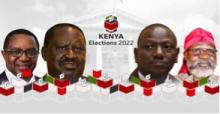Press Freedom Under Threat in Kenya’s 2022 Presidential Elections
Submitted by fkakooza on
Threats against journalists surfaced in the Kenyan presidential elections of 2022 despite strides the media had made to cover them in an objective, balanced and fair manner.
The electoral process was associated with various threats to press freedom. The presidential candidates included David Mwaure Waihiga of Agano Party, Prof. George Wajackoyah of the Roots Party, Raila Odinga of the Azimio coalition, and the eventual winner, William Ruto, of the United Democratic Alliance (UDA).



